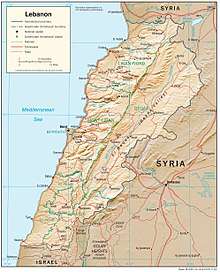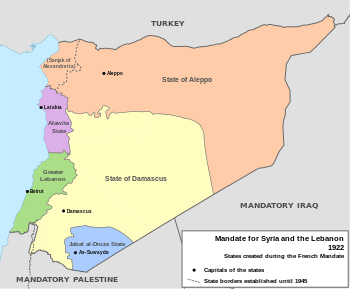Lebanon–Syria border
The Lebanon–Syria border is 394 km (245 m) in length and runs from the Mediterranean coast in the north to the tripoint with Israel in the south.[1]

Description
The border starts at confluence of the Nahr al-Kabir river with the Mediterranean Sea, and then follows this river eastwards some distance inland. The Lebanese border forms a salient to include the villages of Karha and Knaisse Akkar in the north-east of Akkar District, just west of the Syrian Lake Homs, before turning to the south-east via a series of irregular lines, cutting across the Orontes (at 34.455°N 36.490°E) and the trans-Beqaa road between Qaa and Al-Qusayr (at 34.4217°N 36.5433°E), reaching the Anti-Lebanon mountains at about 34.22°N 36.60°E. The border then turns towards the south-west, generally following the Anti-Lebanon mountains via a series of irregular lines, until reaching Mount Hermon.
The precise location of Lebanese-Israeli-Syrian tripoint is unclear due to Israel's occupation of the Golan Heights stemming from the 1967 Six Day War.[2] The de jure tripoint lies on the Hasbani River, a tributary of the river Jordan, at 33.2422°N 35.6244°E, just north-east of the Israeli town of Ma'ayan Baruch. The de facto tripoints lie on the tripoint(s) with the United Nations UNDOF Zone. The situation is further complicated by the dispute over the Shebaa farms area on the Golan-Lebanon border.[3]
History

At the beginning of the 20th century what are now Lebanon and Syria belonged to the Ottoman Empire, with the Mount Lebanon semi-autonomous as the Mount Lebanon Mutasarrifate. During the First World War an Arab Revolt, supported by Britain, succeeded in removing the Ottomans from most of the Middle East. However as a result of the secret 1916 Anglo-French Sykes-Picot Agreement Britain and France split the Ottoman domains between them, with Syria and Lebanon falling under a French mandate.[4]
In 1920 France split its mandate into several political entities, one of which was an expanded Mount Lebanon Mutasarrifate referred to as 'Greater Lebanon', set up chiefly so as to provide a national polity for the generally pro-French Maronite Christians.[5] The process leading to the precise delineation of the frontier is unclear, though it appears to have been based on a map stemming from the 1860s French expedition to the region which was championed by Lebanese nationalist Bulus Nujaym.[6][7] Many Syrian nationalists opposed the new entity, seeing Lebanon as an integral part of Greater Syria.[8] The remaining Syrian states were eventually merged into one Syrian polity in 1930s, minus Lebanon (and also Hatay, which became part of the new Republic of Turkey). Both Lebanon and Syria gained full independence in the period 1943-46.[9][10]
Relations between the two new states were often tense, and a precise border has never been fixed officially with any precision, in spite of Lebanese demands to this effect and some preliminary work to this effect in the 1950-60s.[11][12] Many Lebanese feared that its larger neighbour harboured designs to annex the country. In 1975 long-standing sectarian tensions within Lebanon erupted into civil war, prompting Syria to occupy the country the following year; Syrian troops were to remain in Lebanon until 2005.[13][14]
Since 2011 the border region has been seriously affected by the spillover from the Syrian Civil War.
Border crossings
- Arida Border Crossing[15]
- Jusiyah al-Amar-Qaa Border Crossing[15]
- Masnaa Border Crossing, on the road between Damascus and Beirut[15]
- Dabousieh Border Crossing
- Talkalakh Border Crossing
- Zemrani Border Crossing
- Hamra Border Crossing
References
- CIA World Factbook – Syria, retrieved 3 April 2020
- Golan Heights profile 25 March 2019 BBC
- Kaufman, Asher (2004). "Understanding the Sheeba Farms dispute". Palestine-Israel Journal. 11 (1). Retrieved 22 July 2006.CS1 maint: ref=harv (link)
- Cleveland, William L. (2009). A History of the Modern Middle East (4th ed.). Boulder, Colorado: Westview Press. p. 163. ISBN 978-0-8133-4374-7.
- Emmanuel Brunet-Jailly (28 July 2015). Border Disputes: A Global Encyclopedia [3 volumes]: A Global Encyclopedia. ABC-CLIO. pp. 353–. ISBN 978-1-61069-024-9.
- Marwan R. Buheiry (1 June 1981). "Bulus Nujaym and the Grand Liban Ideal, 1908–1919". Intellectual Life in the Arab East, 1890 to 1930. Syracuse University Press. p. 63. ISBN 978-0-8156-6086-6.
- Meir Zamir (1988). The formation of modern Lebanon. Cornell University Press. pp. 15–16. ISBN 978-0-8014-9523-6.
Nujaym’s formulation was to become the basis for Lebanese Christian arguments in favor of a Greater Lebanon. It stressed the national rather than economic aspects of that goal. Only extended boundaries would enable Lebanon to exist as an independent state. Nujaym told the European public that the Lebanese question required a definite solution: the establishment of an independent Christian state.
- Cleveland, William L. (2009). A history of the modern Middle East (4th ed.). Boulder, Colo.: Westview Press. p. 237. ISBN 978-0-8133-4374-7.
- Traboulsi, Fawwaz (2007). A history of modern Lebanon (1. publ. ed.). London: Pluto Press. p. 107. ISBN 978-0-7453-2438-8.
- Chaitani, Youssef (2006). Post-colonial Syria and Lebanon : the decline of Arab nationalism and the triumph of the state (Reprinted. ed.). London: I.B. Tauris. p. 159. ISBN 9781845112943.
- "Lebanon-Syria Border" (PDF). Now Lebanon. 2009. Retrieved 3 April 2020.
- see United Nations Security Council Resolution 1680 (2006)
- Stout, Theodore (2002). "THE SYRIAN INTERVENTION IN LEBANON 1975-76:A FAILURE OF STRATEGY" (PDF). aiswest.com. p. 26.
- "Retrait syrien total fin avril au plus tar" (in French).
- Paul Doyle, (2012) Bradt Travel Guide - Lebanon, pgs. 51-2